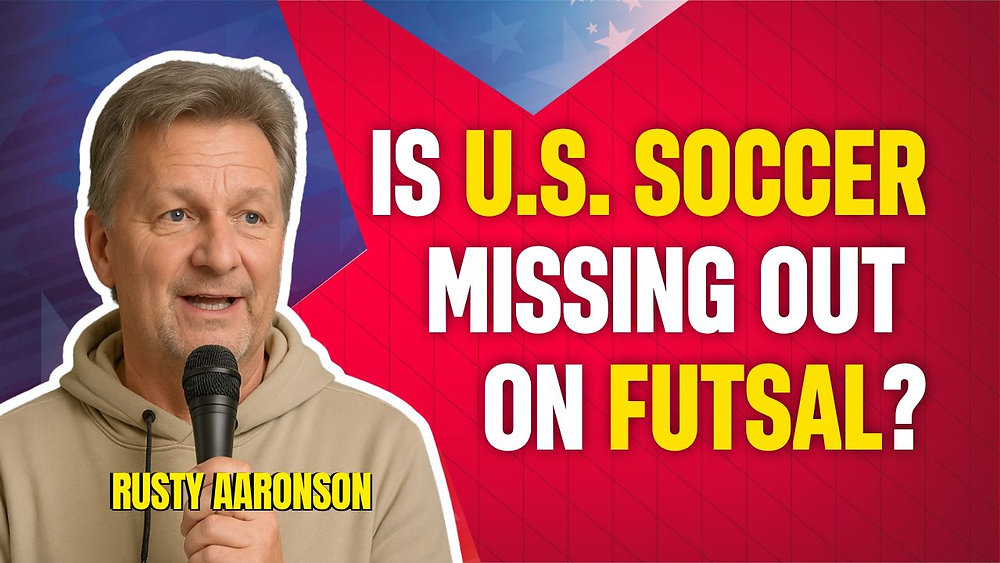
Rusty Aaronson and the Truth About Youth Development: Why the Small-Sided Game Matters
When Rusty Aaronson sat down to speak about the path his children—Brendan and Paxten—took to professional soccer, he didn’t speak in buzzwords or marketing slogans. He spoke with honesty, clarity, and lived experience.
There were no claims of early specialization or elite academy shortcuts. What he offered instead was something far more valuable: a reminder that true development begins with simplicity, joy, and repetition in small spaces.
For those of us in futsal, his words didn’t just resonate—they confirmed everything we already believe.

The Foundation Was Built in a Basement.
Aaronson spoke of a small, unfinished room in their New Jersey home—nicknamed “The Dungeon”—where he laid down green carpet and two mini goals. It wasn’t fancy. It wasn’t designed with any curriculum in mind. It was a space to play.
“It wasn’t big… but it had walls. You’d hear the ball pounding on them five, six days a week… everything was first touch.”
What he created, perhaps unknowingly, was a perfect model of small-sided football: high-frequency touches, limited space, constant repetition, and decision-making under pressure. This is the essence of futsal—and this is the foundation that shaped Brendan and Paxten’s technical ability.
They didn’t need a perfectly manicured field. They needed a place to compete, improvise, and build comfort with the ball. And that’s exactly what the small-sided environment provides.
Too Much Instruction, Not Enough Play
When asked what he would change about the current youth soccer system in the United States, Aaronson’s response was immediate:
“There’s too much instruction… I think the kids don’t play enough. The free play teaches the game.”
This critique is not new—but it’s rarely expressed so directly by someone whose children have reached the top levels of the game. In many ways, this is the central flaw in modern youth development: over-coached, over-structured, and underplayed.
Across the country, we see children standing in lines during training, following scripts instead of solving problems, and spending weekends traveling long distances for matches that offer limited developmental value.
Meanwhile, what actually produces technically confident and tactically aware players—playing in tight spaces, under pressure, with the ball at their feet—is often de-prioritized or misunderstood.
Aaronson’s call is clear: we must reintroduce play, particularly between the ages of 7 and 12. We must create environments where players are free to experiment, fail, adapt, and grow.
Futsal Is Not a Side Activity
Everything Rusty described—tight quarters, repetition, decision-making, first touch emphasis—is what futsal delivers by design.
In countries that consistently produce top-level footballers, futsal or small-sided play is part of the culture. It’s not a seasonal tool or an indoor substitute. It’s foundational.
Yet in the U.S., futsal is still often misunderstood by families who see it as secondary to 11v11 or 9v9 soccer. Worse, many young players are pulled away from futsal at the exact moment it’s helping them most.
It is disheartening to see players leave futsal and small-sided activities at 8 or 9 years old—just when they’re beginning to absorb spatial awareness, timing, and control—because a travel soccer program offers an “elite” badge or a heavy game schedule. These decisions often come from good intentions, but they reveal a lack of information about what true development looks like.
In truth, weekend tournaments and long car rides do little for technical growth. But an hour in a futsal session can sharpen ten different elements at once.
Patience and the Long View
Throughout the interview, Aaronson returned to a theme that is often overlooked in youth sports: patience.
There’s no secret sauce… you stay on the path, and the trees will fall behind you.
This perspective is rare in today’s environment, where early success is often mistaken for long-term potential. Rusty emphasized the importance of trusting the process, not rushing players into results, and not panicking when others appear to be progressing faster.
In a small-sided environment like futsal, patience is essential. Progress is not always linear. But over time, the gains become undeniable.
A Message Every Parent Should Hear
Rusty Aaronson’s story is not just about two talented sons. It’s about creating the right environment, resisting pressure, and understanding that development is not a race.
His interview is essential listening for any parent navigating the youth soccer landscape today. It offers clarity at a time when there is so much noise.
We encourage every family—especially those curious about futsal—to listen to his full conversation. Not because it validates our work, but because it reveals what really matters in raising good players and good people.
This is what we believe in. This is what we train for. And this is the kind of message the American soccer system needs more of—not less.

.png)









